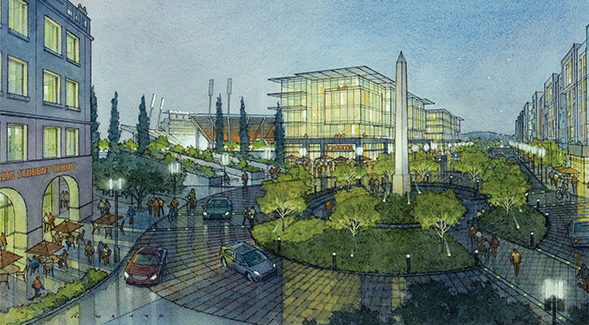A Vision for the Valley
By partnering outside the university, SDSU will have even more to offer the region.

“Partnering outside the university gives students and faculty access to San Diego’s best minds, who are focused on problem-solving, and whose work powers the region.”
View the SDSU Mission Valley website to learn more about the site plan and view renderings.
This story appears in the summer 2018 issue of 360: The Magazine of San Diego State University.
The 121-year synergy between San Diego and San Diego State University has been strong and fruitful. Since its earliest days as a college founded to prepare the region’s educators, the institution took on the mantle of San Diego’s university.
Today, SDSU’s low- and no-cost clinical services, community outreach, internship programs, alumni hiring networks and joint artistic endeavors continue to underscore that connection. Not to mention the 200,000-plus alumni who live in the region.
SDSU’s plan for a Mission Valley campus would intensify the university’s solid relationships with San Diego and greatly expand its capacity to address today’s critical problems. The plan would also cement SDSU’s role as an innovator in promoting entrepreneurship on campus and working with private and government partners to develop new avenues of research and technology.
SDSU has several objectives for a Mission Valley campus, should it have the opportunity to purchase the city-owned site where SDCCU Stadium now stands. The university would pay fair market value for the land; build a world-class innovation and research campus; build and maintain a river park; build a multi-use stadium for NCAA football, professional soccer and community events; and partner in the construction of affordable and market-rate housing for students, faculty, staff and the general public.
Additionally, an SDSU campus in Mission Valley would have public-private and public-public partnerships built into its DNA, brewing up a potent mix of intellectual expertise, technical know-how, community engagement, and entrepreneurial boldness, said Stephen Welter, vice president for research and dean of Graduate Affairs.
“Partnering outside the university gives students and faculty access to San Diego’s best minds, who are focused on problem-solving, and whose work powers the region,” he said.
From the ground up, SDSU would join with local companies and agencies to develop the new campus, which would connect to the main campus via a quick trolley ride. With financially secure partners helping to capitalize the development, the university will not rely on taxpayer dollars to build out SDSU Mission Valley, but instead on strategic private partners eager to work with SDSU’s students and researchers.
It’s a vision SDSU officials witnessed firsthand during a recent field trip to Atlanta, where Georgia Tech has completed campus extensions that enhanced its ties to the community and private industry.
Georgia Tech’s Technology Square is a multi-block development in Atlanta’s Midtown neighborhood. Anchored by university-owned buildings and leased to carefully selected companies—mostly from the tech and entrepreneurial sectors—Technology Square reinvigorated the community when it was built in 2003.
There, partners and tenants like Home Depot, Delta Airlines and Panasonic benefit from working next door to world-class scientists and engineers. In turn, they offer internships and hiring opportunities to Georgia Tech students, and collaborate with researchers on projects co-funded by private and public grants.
In Mission Valley, SDSU hopes to build a similar entrepreneurial ecosystem. San Diego is home to countless innovative companies and non-profits not only in the tech sphere, but also in manufacturing, clinical services, environmental planning and biomedical diagnostics. With these companies as development partners, SDSU students would benefit from expanded internships and career opportunities. In turn, businesses, non-profits and government agencies would get to plug into the university’s knowledge base.
“The co-location of SDSU’s intellectual capital with their enterprise allows for the direct flow of ideas, which benefits both sides of the relationship,” Welter said.
The San Diego region is hungry to team up with intellectual partners, he said, and to that end, the university is committed to fostering a sense of entrepreneurship, engagement, and adventure in its faculty and students.
“We are creating a culture of openness to these kinds of partnerships,” Welter said. “We’re training our students to think differently, and encouraging our faculty to think entrepreneurially.”
Related articles:
The Logic of SDSU Mission Valley
A Stadium for San Diego



